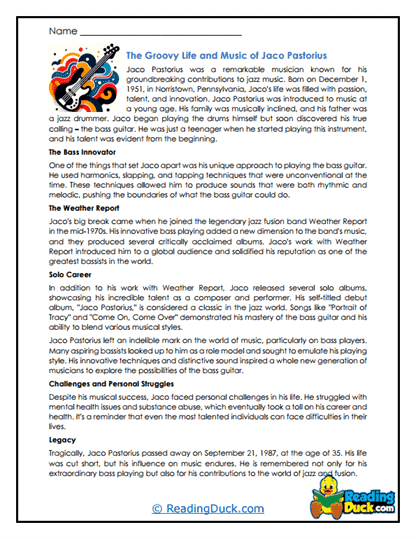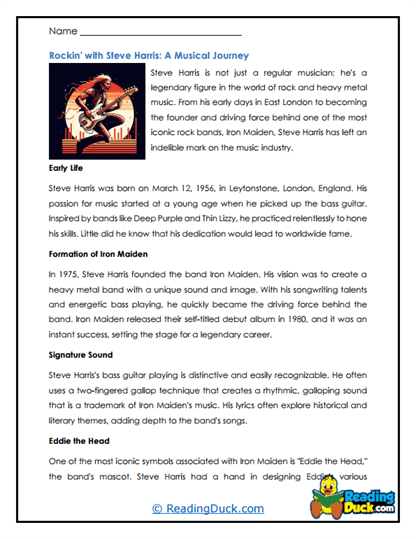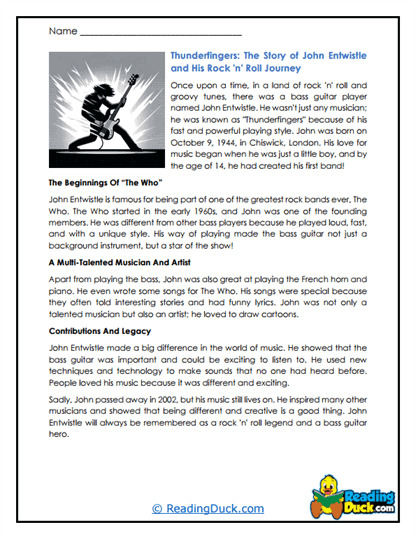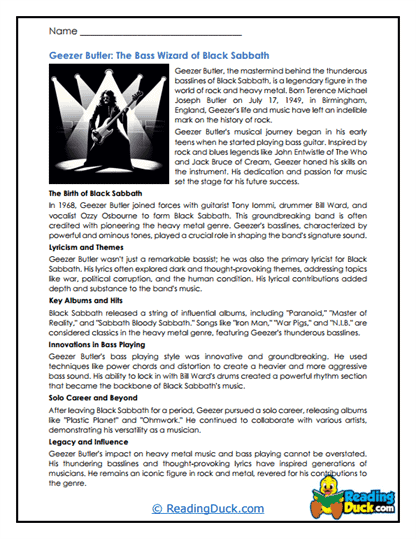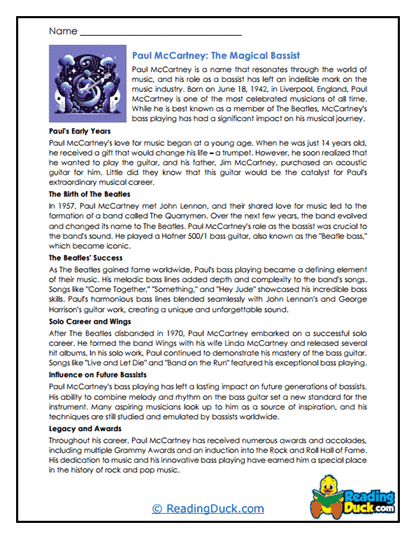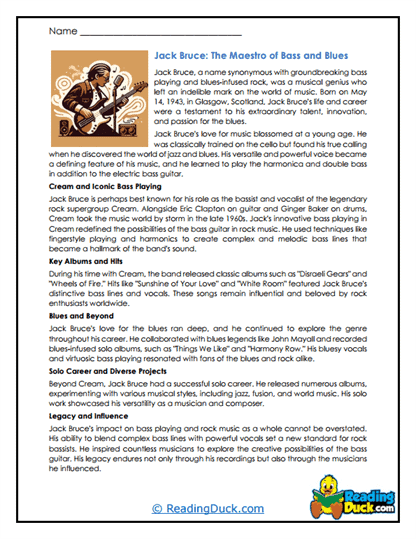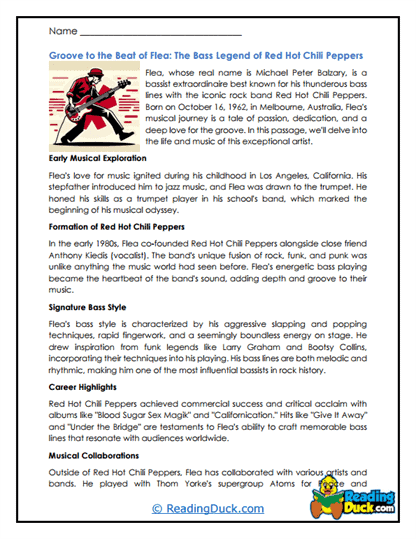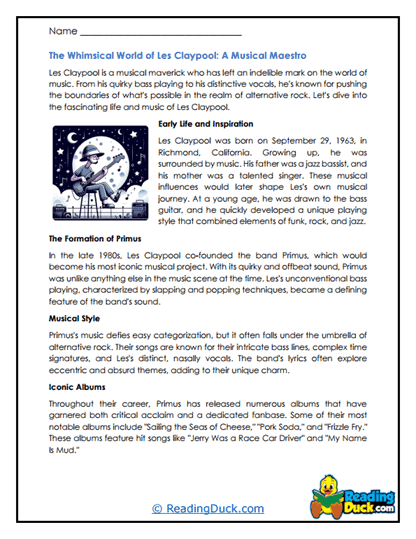Bassists Worksheets
About Our Bassists Worksheets
Our Bassists worksheets provide an engaging and comprehensive exploration of some of the most influential bass players in music history. From jazz to rock, funk to blues, these worksheets delve into the lives, careers, and styles of legendary bassists who have shaped the sound of music across genres. This collection is designed to help students appreciate the crucial role bassists play in a band, understand different styles of bass playing, and explore the cultural impact these musicians have had on the world of music.
Each topic in our Bassists collection contains several worksheet sets. These sets are carefully crafted to build students' understanding and appreciation of these musicians through a variety of engaging activities. Each worksheet set includes:
- Multiple Choice Questions: These questions test students' comprehension of the reading passages, focusing on key facts about the bassist's life, career, and musical contributions. This format helps reinforce students’ understanding of the material and encourages them to pay attention to details.
- Short Answer Questions: This format challenges students to reflect on what they’ve learned by answering questions in their own words. These questions encourage deeper thinking and help students develop the ability to articulate their thoughts and insights about the bassist's influence and style.
- Open-Ended Questions: These questions invite students to explore their personal responses to the material, asking them to express their opinions, preferences, or interpretations related to the bassist's music and legacy. This format fosters critical thinking and allows students to connect with the material on a more personal level.
Each worksheet set is designed to assess students’ understanding while enhancing their connection to the material. An answer key is provided for every question sheet, making it easy for educators to review and evaluate students’ progress. All worksheets are available as PDF files, which can be easily viewed electronically, downloaded, and printed.
Exploring the Legends of the Low End: Understanding the Role of Bassists in Music
Bassists are often the unsung heroes of the music world, providing the rhythmic foundation and harmonic support that allows a band’s sound to shine. When introducing students to the world of bassists, it’s essential to highlight how these musicians have shaped the sound of various genres and left an indelible mark on music history. From the deep grooves of funk to the driving force of rock and roll, bassists bring depth and texture to music that is both felt and heard.
Key Aspects of Bassists:
- The Role of the Bass in Music: The bass guitar, or double bass, is central to the rhythm section of a band. It locks in with the drums to create the groove that underpins the entire song. The bassist’s role is to bridge the rhythm and melody, providing a steady pulse while also adding harmonic richness. Students should understand how the bass shapes the feel of a song, often driving the music forward and giving it a sense of movement.
- Influential Bassists Across Genres: Each genre of music has its legendary bassists who have pioneered new techniques and styles. For example, in jazz, Charles Mingus brought the double bass to the forefront with his innovative playing and compositions. In rock, John Paul Jones of Led Zeppelin and Paul McCartney of The Beatles set the standard for bass playing with their melodic and rhythmic approaches. In funk, Bootsy Collins and Larry Graham revolutionized the instrument with their slap bass techniques, which added a percussive element to the groove. Exploring these musicians’ contributions helps students appreciate the diversity and evolution of bass playing.
- The Evolution of Bass Playing Techniques: Over the years, bass playing has evolved with the development of new techniques and technologies. Techniques such as slap bass, tapping, and harmonics have expanded the expressive possibilities of the instrument. Students should learn about these techniques and how different bassists have used them to create unique sounds and styles. Understanding the evolution of bass playing also highlights how musicians continually push the boundaries of their instruments.
- Cultural Impact and Legacy: Beyond their technical skills, bassists have had a profound cultural impact. Their music has influenced countless other musicians and shaped the sound of entire genres. For instance, Jaco Pastorius redefined what the electric bass could do in jazz and fusion, while Carol Kaye’s work as a session bassist helped define the sound of 1960s pop music. Recognizing the cultural significance of these bassists helps students see the broader impact of music on society.
- Connecting Music and Emotion: Bassists play a crucial role in conveying emotion through music. The bass line can evoke feelings of excitement, tension, or melancholy, depending on how it is played. Students should explore how bassists use dynamics, tone, and rhythm to create emotional responses in listeners. Understanding this connection between music and emotion can deepen students’ appreciation of the art form.
By exploring these key aspects of bassists, students can develop a well-rounded understanding of the role these musicians play in shaping music. They will learn to appreciate the technical skills, creativity, and cultural impact that bassists bring to the music world. This knowledge not only enhances their musical education but also fosters a deeper connection to the music they listen to and play.
The Importance of Music Education
Music education is vital for students of all ages because it nurtures creativity, enhances cognitive development, and fosters emotional expression. Learning about music, whether through playing an instrument, understanding music theory, or studying influential musicians, helps students develop skills that are transferable to other areas of life. It encourages discipline, perseverance, and teamwork, as well as improving memory and problem-solving abilities.
Furthermore, music education provides students with a means of self-expression and emotional release. It allows them to explore their own creativity and connect with others on a deeper level. By studying music and the musicians who create it, students gain a greater appreciation for the cultural and historical significance of music, which enriches their understanding of the world around them.
Integrating These Worksheets in a Curriculum
To maximize the effectiveness of our Bassists worksheets, teachers and parents can incorporate them into their lessons in various creative and productive ways. Here are some tips for using these worksheets in the classroom or homeschool setting:
- Thematic Lessons: Create themed lessons around specific genres or periods in music history. For example, you could design a unit on the evolution of rock music, using the Bassists worksheets to explore how bassists like John Entwistle and Flea contributed to the development of the genre.
- Comparative Analysis: Encourage students to compare and contrast the styles and techniques of different bassists. This could be done by selecting two bassists from different genres and discussing how their playing styles reflect the characteristics of their respective genres.
- Interactive Listening Sessions: Pair the worksheets with listening sessions where students can hear the bassists in action. Use audio or video recordings to showcase the musicians discussed in the worksheets, helping students connect the theoretical aspects of their studies with the actual sound and feel of the music.
- Creative Projects: Assign creative projects where students can create their own bass lines or analyze the bass lines in their favorite songs. This hands-on approach allows students to apply what they’ve learned from the worksheets in a practical and engaging way.
- Cross-Disciplinary Connections: Link the study of bassists with other subjects such as history, social studies, or literature. For example, discuss how the social and cultural context of the 1960s influenced the music of bassists like James Jamerson and how their work reflects the era’s social movements.
- Group Discussions: Use the open-ended questions in the worksheets as prompts for group discussions. Encourage students to share their thoughts on the music, the musicians, and the cultural impact of the bassists they are studying. These discussions can help students develop critical thinking skills and learn to articulate their opinions effectively.
- Assessment and Feedback: Use the multiple choice and short answer questions to assess students’ understanding of the material. Provide personalized feedback that highlights their strengths and areas for improvement, helping them grow as both students and music enthusiasts.
By using these strategies, teachers and parents can help students gain a deeper understanding of the role of bassists in music, develop critical listening skills, and foster a lifelong appreciation for music. The Bassists worksheets are a valuable resource that can be integrated into a variety of educational settings, making music history and theory accessible and engaging for all students. Through consistent practice and exploration, students will not only learn about the great bassists of the past and present but also develop a greater appreciation for the art of music itself.
